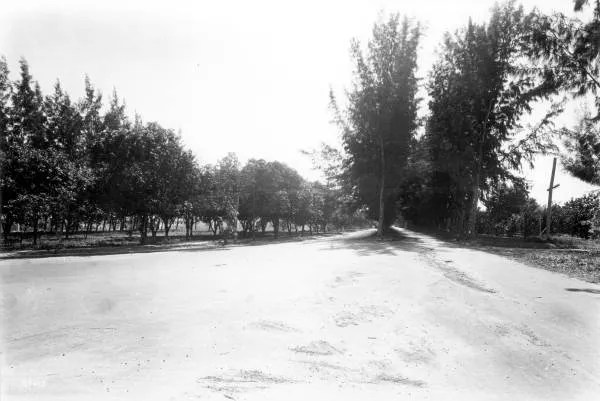
State Archives of Florida / Fishbaugh

Audio By Carbonatix
Before Miami Beach was the city of Miami Beach, pioneer John S. Collins planted a row of Australian pine trees along the barrier island to shield his avocado and mango groves from the wind. More than 100 years later, those pines are still standing – a remarkable feat, considering the average lifespan is 40 to 50 years.
Over the past few years, though, city officials have worried that the 70-plus-foot trees are weak enough to topple over and hit a car or pedestrian. This past September, a pair of arborists assessed them and confirmed that at least 254 of the 271 pines will need to be substantially pruned to avoid a worst-case scenario. Damage from this year’s hurricane season has also doomed at least two of the trees – last week, the county chopped down one on the 4200 block and another on the 4400 block that
“The Australian pines along Pine Tree Drive in Miami Beach have survived many years and are in healthy condition, but it is important to remember that all trees have a lifespan,” the report says. “Structural failures will be the demise of these historic trees; the Australian pine trees will eventually break apart or tip over.”

Two photos from Miami Beach documents show a damaged Australian pine compared to a healthy one.
photos by City of Miami Beach
Will you step up to support New Times this year?
At New Times, we’re small and scrappy — and we make the most of every dollar from our supporters. Right now, we’re $18,000 away from reaching our December 31 goal of $30,000. If you’ve ever learned something new, stayed informed, or felt more connected because of New Times, now’s the time to give back.
On a positive note, the report from the arborists says the pines between 46th and 30th Streets could live up to ten years longer if properly cared for. As the trees die or become a hazard, though, the city won’t be able to easily replace them. Because their root systems release a toxin into the soil, Australian pines are considered an invasive species and thus cannot be replanted. The toxins also make it difficult to replace the pines with a different kind of tree because the soil has to be removed before a new species can be planted.
Because Pine Tree Drive is a county road, any decisions Miami Beach makes about the pines must be made in conjunction with Miami-Dade. Pruning all 254 trees could cost about $200,000, money that isn’t in the city’s budget.
“In the next month or two, we’re hoping to have a plan in place on how we’re going to move forward,” says Betsy Wheaton, Miami Beach’s environment
In all likelihood, the trees will be replaced with another type of pine. After Pine Tree Drive was designated a historic place by the city in 2001, the county Historic Preservation Board approved replacing the Australian pines with slash pines when necessary.
While city officials wait for a final report about the pines to be released in January, Wheaton says protecting the trees for as long as possible is a top priority.
“As long as the trees are healthy,” she says, “we’re not looking to bring down healthy trees.”